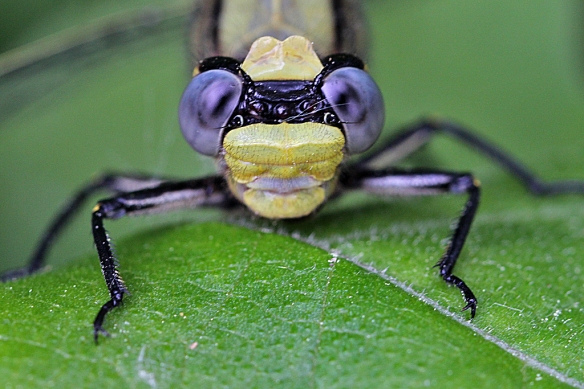On a cool morning recently, the dragonflies were a bit comatose sitting on the leafy vegetation in the backyard, waiting for some sun to heat them up. They let me get really close to take full advantage of my macro lens magnification.

The Horned Clubtail dragonfly face resembles a monkey’s, with its widely spaced goggle eyes and big broad lips. Clubtails are one of only two groups of dragonflies that have their eyes so widely separated. A tall, plate-like yellow shield between the eyes is typical of this species.
Black bumps between the eyes are motion-detecting ocelli (singular, ocelllus). Each compound eye contains more than 30,000 light-sensing photoreceptors (ommatidia), giving this highly specialized predator incredible visual acuity in all directions. For more detail on the marvels of dragonfly vision, see my earlier post on this subject.
From this angle it looks like the dragonfly wears transparent helmets over its eyes.

Viewed from the top, the transparent-looking shields cover only the front of the eye. I admired the intricate pattern of yellow and black on the head and thorax of this female Horned Clubtail, which allow us humans to tell species apart — but what do they mean to another dragonfly?
Some dragonflies species are like some bird species with sex-dependent color patterns that distinguish male and female from one another. Horned Clubtail males and females look alike, except for the business end involved in reproduction.

The Horned Clubtail male’s terminal segment (the cerci) have curved spikes resembling cow horns (hence, the species name), used to grab the female’s head during mating. (This shot taken with the Canon 100-400 telephoto lens.)

The Horned Clubtail female’s terminal segment shows short, straight cerci used in egg-laying. (This shot taken with the 90 mm Tamron macro lens.) It looks like there are fine hairs that project from the surface of the abdominal segments — I’ve no idea what they are for.
Comatose dragonflies make great subjects for macro photography, revealing details of structure I’ve never seen or thought about before.

I find that I am fascinated by dragonflies lately. Cool pictures!
They have such odd features — most of which I have no clue as to their function, not being an insect biologist. All those hairs and spines and plates…curiouser and curioser.
It sounds like I need to get out earlier. Excellent shots!
Great job. Love the focus and details
Thanks! They are such interesting critters.
Awesome dragon! Excellent photos!
Thanks Walter! it always helps when they sit perfectly still while I creep ever closer.
Una Serie Preciosa, Sin Duda Alguna Un Trabajo Dificil De Realizar, Un Saludo…
Muchas gracias, Jose! 😀